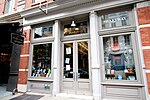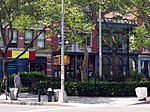Chambers Street station (IRT Sixth Avenue Line)
1878 establishments in New York (state)1938 disestablishments in New York (state)Defunct New York City Subway stations located abovegroundFormer elevated and subway stations in ManhattanIRT Sixth Avenue Line stations ... and 3 more
Manhattan railway station stubsRailway stations closed in 1938Railway stations in the United States opened in 1878
Chambers Street was a station on the demolished IRT Sixth Avenue Line in Manhattan, New York City. It had two tracks and two side platforms. It was served by trains from the IRT Sixth Avenue Line and opened on June 5, 1878. It closed on December 4, 1938. The next southbound stop was Park Place. The next northbound stop was Franklin Street. The Chambers Street – World Trade Center / Park Place station complex can be found within the vicinity of the former elevated railroad station.
Excerpt from the Wikipedia article Chambers Street station (IRT Sixth Avenue Line) (License: CC BY-SA 3.0, Authors).Chambers Street station (IRT Sixth Avenue Line)
Chambers Street, New York Manhattan
Geographical coordinates (GPS) Address Nearby Places Show on map
Geographical coordinates (GPS)
| Latitude | Longitude |
|---|---|
| N 40.715508333333 ° | E -74.009266666667 ° |
Address
Chambers Street
Chambers Street
10007 New York, Manhattan
New York, United States
Open on Google Maps







